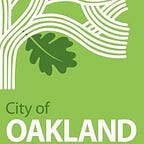Talking Parking on Telegraph
(This post is the third in a series about the Telegraph Avenue ‘complete streets’ project. The project includes a road diet to calm traffic, parking-protected bike lanes to make bicycling safer and more comfortable, and pedestrian improvements to make the street safer and more walkable. Read our first post that looks at changes in safety on Telegraph, and second post that discusses mode shift.)
The first two posts in our Medium series about Telegraph Avenue have focused on changes for pedestrians and bicyclists. But one of the most noticeable changes on Telegraph is about where people park. Drivers now park away from the curb, in “floating” parking lanes. This creates a protective barrier between moving vehicles and the bikeway. In this post, we’re sharing some insights about changes to parking along the corridor.
Fewer parking spots along Telegraph, but more metered spaces on side streets
Installing protected bikeways often introduces changes to on-street parking. When we use parking to protect the bikeway, we often lose a few spaces. This is because we need to keep the view clear for drivers who are making a turn. Because of this, we hold some open space at the beginning and end of each block. On Telegraph, changes to the street configuration also required some more curb space for public transit. This is so AC Transit operators have enough room to pull in and out of the bus stops.
The recent changes on Telegraph eliminated 39 on-street parking spaces between 20th and 30th Streets. This reduced the total from 92 to 53 on-street spaces. This is common with protected bikeway projects, but we’re less than average: according to a study of new protected bikeways in U.S. cities, the number of parking spaces decreases by roughly 67 spots per mile. That’s about 1.2 times the decrease on Telegraph.
Still, we knew it would be important to replace some of the short-term parking to support businesses on Telegraph. So we added hourly parking meters on side streets next to Telegraph, including on 24th, 25th, and 26th Streets. These changes added 22 “new” metered spaces to the corridor. This meant there was only a reduction of 17 metered spaces rather than 39, or an 18% reduction in metered spaces versus 42%.
18% decrease in spaces on Telegraph, but 10% increase in use
Parking use is the amount of time a spot is occupied or empty. The “sweet spot” for a parking area is between 65% and 85% occupied. Below 65% could mean that the price is too high, or that there is not enough demand. Above 85% could mean that demand is very high and people are having a hard time finding a parking spot.
To measure the parking use on Telegraph, we tracked revenue data from our parking meters. From this data, we found that average daytime meter use on Telegraph increased by as much as 10% after the project’s changes to parking. The peak hours of parking use appear to be from 1pm to 2pm, with the peak use rate of 52%, up from around 42% before the project.
Typically, if we found a street with 52% peak use, we might want to address price (by lowering the price) or demand (by change time limits). We’re not ready to change things on Telegraph just yet though.
Mainly this is because there are limitations to only using revenue data to assess use. Think about it: most people leave time on the meter when they drive away, and some don’t pay at all. So, we know we are undercounting actual use if we just look at meter revenue. At the same time, we think this data tracks usefully to the actual use and may be a good proxy for overall trends. Meaning: the 10% change in revenue probably equals a 10% increase in actual use — still smaller than the 18% change in on-street parking spots.
In general, we want to make changes based on good data, and good parking data can be difficult to collect. Manual surveys are time-consuming and expensive to conduct. Wireless sensors beneath the street surface can be useful, but are challenging to install. (Sensors used in San Francisco’s SFpark program also faced interference from buried power lines and have limited battery life.)
Sales tax receipts show positive trends
Another metric to look at related to parking impacts is economic trends. On Telegraph, we reduced the metered parking supply by 18% but local business sales tax receipts increased by 9%. These sales tax receipts suggest that local shops on Telegraph have seen increased sales after the implementation of the Telegraph project — parking changes and all.
If you’re interested in all things parking, stay tuned! Our OakDOT team is at work implementing new parking policies and focusing on downtown Oakland first.
Thanks for reading!
